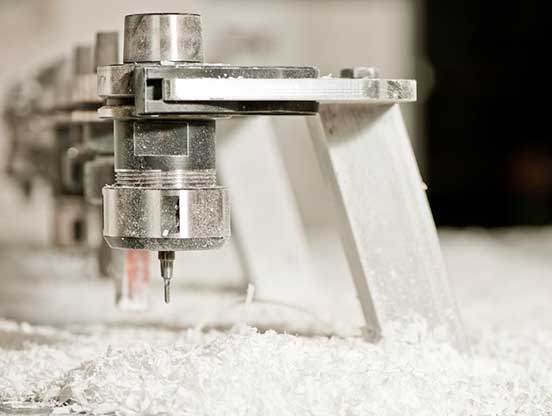
Panels of Corian® are worked using the same techniques and equipment (widia saw blades) used for wood. However, there are also exclusive procedures, such as gluing, which makes it possible to assemble different elements with imperceptible joints, and thermoforming, used to create undulated surfaces, three-dimensional volumes and organic forms.
Panel Thicknesses and Dimensions
Corian® is produced in 4, 6, 12 and 19 mm panels, in dimensions ranging from 2490 to 3658 mm and lengths of 760-930-1300 mm. The most common thicknesses are 12 mm and 6 mm, based on the type of installation.
Routing
Surfaces in Corian® can be routed to create elements to be glued together, engraved or carved to create cladding panels featuring designs or continuous three-dimensional motifs. Routing the back of a panel makes it possible to produce LED backlit logos and images: the external surface remains unaltered and the pattern is visible only when the light is on.
Thermoforming
Corian® can be shaped by thermoforming, a process that uses heat to soften this material, which becomes malleable enough to be moulded into three-dimensional forms characterised by gentle curves. The maximum effect is obtained using Corian® Glacier White, and in general all light colours, accepting a slight colour change in correspondence with the fold, invisible in the white version.
There are various methods for thermoforming Corian®. The most common is two-dimensional thermoforming, which requires CNC moulds of the exact form to be shaped. Three-dimensional thermoforming requires the creation of moulds that for more complex elements also require a counter mould to obtain the desired effect.
The only limit on the size of thermoformed elements is the dimension of the warming oven.
In all cases pieces can be glued together with imperceptible joints. Thermoforming is assisted by the use of presses and vacuum forming sheets.
Assembly, Gluing and Sanding
Assembly, gluing and sanding are the processes that have made Corian® famous in the world of architecture. It is the only material that can be used to create a monolith without any limits on size and without visible joints.
A liquid glue mixed with a catalyst is injected between two elements to be joined together through a special nozzle. The two elements are thus held tightly together by special clamps. After approximately 40 minutes, excess dry glue is removed using an orbital sander and various passages of sandpaper, to obtain a homogenous surface.
Self-Supporting Structures
As a finishing material Corian® requires a supporting structure because it contains only 30% of a binding agent (acrylic resin) and thus it tends to flex over time. Using the technique of three-dimensional design and thanks to thermoforming, it is nonetheless possible to make this material self-supporting, with notable advantages in terms of aesthetics, reduced fabrication costs and reduced weight.
Back-Lighting
Corian® Glacier White can be backlit, beginning with 12 mm panels. LEDs are preferable to neon fixtures as they generate less heat in the space behind the panel and make it easier to substitute the lighting system. By carving into different thicknesses of Corian® (from 3 to 9 mm) it is possible to obtain totally unique lighting effects, impossible to replicate with other materials. The possibility to create three-dimensional logos and images by carving into this material using CNC routers makes it ideal for cladding bar counters, reception desks in clinics, hospitals and shopping centres, for finishing walls and façades with logos or motifs projected in movement, both inside and outside.







